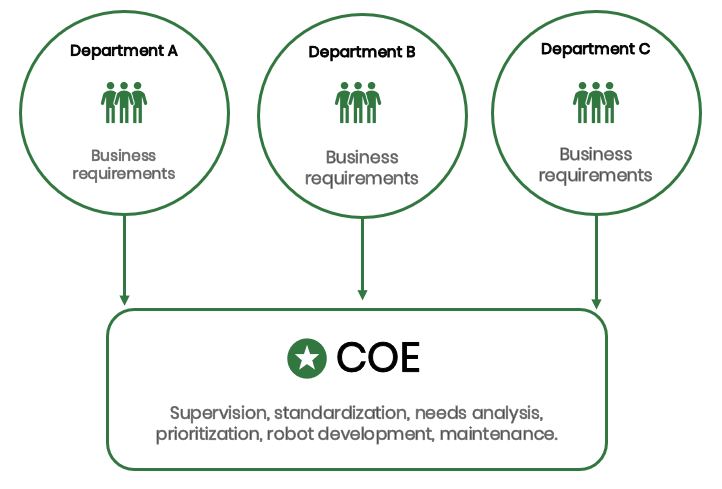Center of Excellence – how does it support automation?
Today I would like to come up with a subject of building competency center for Robotic Process Automation (commonly used terms are Center of Excellence – CoE, Center of Competence – CoC). The creation of CoC is a crucial part of supporting the automation process, especially when bots are to stay with us for a longer time. What will be relations of CoE with other units in an organization, and what are the main areas that should be monitored?
From a perspective of the scope of services provided through CoE, we can distinguish three operating models.
- Center of Excellence – the centralized model
In this case, business units (BUs) present their automation needs, and the CoE carries out the rest of the works. These are standards of supervision, HR management, and work prioritization, implementation management, production support, and so on.
This model allows smooth RPA initiatives management in the first few months of implementing technologies in the organization. Its most significant advantage is the adaptability of automation goals at the global level to the organization’s strategy as well as vision. Thanks to the centralization of manufacturing competencies and high specialty, a centralized model facilitates the acquisition of knowledge, and it is more efficient from the costs of the project point of view.
In addition, standardization of processes allows consistent progress reporting and analyzing at the level of the entire organization.
The centralized CoE model.
Of course, this solution is not a perfect one. It is time for a fly in the ointment. Due to the competencies centralization, identification of processes to automate will be hindered until business users will not understand which processes can and should be automated. At a later stage or robot operation in an organization, there may be a difficulty with prioritization of already identified processes and business units dissatisfaction because of being left out in the automation plans. Those units that employ more people and carry out more unified processes always win – since economic outcomes of automation are evident sooner.
- Center of Excellence – decentralized model, also called the federated model
BUs deal with business needs identification and also robot implementation. CoE ensures support in the context of standardization, sharing license assets, and robot operation.
Thanks to the delegation of manufacturing competencies to business units, identification and implementation of processes to be robotized are faster. The additional and huge advantage of such an approach is combining industry knowledge on the subject of automates processes with manufacturing competencies. Our project experiences show that this combination allows us to deal with potential issues that may occur during the implementation effectively.
The decentralized (federated) CoE model.
However, this model has its downsides. Among difficulties that may be faced by the organization building CoE in this particular way, decentralized supervision should be mentioned mainly. What follows is the potential lack of synchronization between the vision as well as the strategy of the entire organization and plans covering specified automation flows.
The global ROI in such a model may also be lower due to the longer duration time of the implementation project or the necessity of employing additional specialists creating robots within the framework of BUs.
Consistent reporting of signs of progress in particular initiatives may be another impediment in the organization.
- Center of Excellence – combined model, also called the hybrid model
Allocation of responsibilities for specific areas usually results from the needs of individual BUs. The distinctive feature of this model may be positioning the robots’ creators both in CoE structures as well as in BUs.
Departing from any of the two first models toward the hybrid CoE should be the result of an aware decision of at least mid-term nature so that frequent, ongoing changes in the organization could be avoided. The current and potential limitations that could become essential for a particular organization should be analyzed.
The hybrid CoE model.
It is important to remember that the hybrid model – like the previous ones – also has disadvantages. One of them is the problematic management of the development/consultant RPA team[SS1] , scattered on various organizational units. Awareness and strong support of the HR team, leaders as well as people directly responsible for the professional development of this employee group are needed to address born problems.
An extra challenge is managing RPA initiatives and communicating with teams that are involved in them.
Hopefully, now you understand better the role of CoE in the organization and its relations with other departments. In the next article, a follow-up to this entry, I will more broadly describe areas and tasks that should be dealt with in the Center of Excellence. Until we meet again!
- RPA Consultant
-
A manager with over 15 years of experience in software and technology consulting. A graduate of the Warsaw University of Technology and the Warsaw School of Economics experienced in managing big teams (over 50 FTE) in international programs and projects. He has cooperated with clients from the financial, manufacturing, and telecommunication industries in Europe and the Middle East. At Craftware, he is responsible for consulting and development of RPA services.





